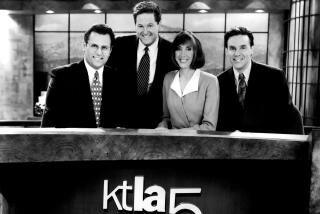A Sameness Marks TV, Radio in ’90 : Media: It was a status quo kind of year for San Diego listeners and viewers.
- Share via
SAN DIEGO — In 1990, local television news, in its zeal toattract new viewers, inadvertently created two new parlor games.
The most popular was the wild and wacky Pin the Hair on Susan game. Day after day, San Diegans gathered around their television sets to try to guess KFMB-TV (Channel 8) anchorwoman Susan Roesgen’s hair color. One day it was blond, the next it was dark brown, as the station attempted to find a winning hair color combination.
Then there was Roger Rotisserie, the game spawned by the arrival of the new KUSI-TV (Channel 51) news program. Participants were awarded points for spotting different movements by stoic anchorman Roger Grimsby. The astute viewer who noticed when Grimsby moved his head received 10 points, 20 points if he blinked, 100 bonus points to catch him smiling.
It was that type of year for local television, as the local stations struggled to attract a regular audience through news programming. The year saw an increase in the amount of local news, but little expansion of content.
As always, style and form--hairstyles and wardrobes--seemed more important than the task of actually improving the quality of the news product. Consistency reigned supreme. New developments, like the Channel 51 newscast, eerily resembled old formulas.
The same was true in the local industry radio, where the most popular game was tracking the local morning programs, sort of a version of “Wheel of Fortune.” The popular “Berger and Prescott” and “Jeff and Jer” shows “defected” to XTRA-FM (91X) and KFMB-FM (B100), respectively. The end result: The hot new shows for 91X and B100 were really old shows.
Throughout the year, both the television and radio ratings were dominated by single stations--the same stations that had dominated in 1989. In television news, KGTV (Channel 10) was No. 1 for the entire year, while KKLQ (Q106), featuring teen-oriented dance tunes, was the big winner in overall radio ratings.
Channel 10 persevered, thanks to slick news presentation--a combination of hard news, zoo stories and light health and fitness features--and consistency, presenting the same faces as the year before. To a degree, that consistency was destroyed in September when Michael Tuck, perhaps the most popular anchorman in town, left for a similar job in Los Angeles.
Although Tuck continues to do commentaries twice a week for the station, reporter Marti Emerald and former Urban League president Herb Cawthorne were brought in to provide their own “Perspective” pieces. The choice of Cawthorne, whose career in the private sector has been plagued by controversy, was particularly noteworthy, primarily because he became the first regular black commentator on local television.
In the main anchor seat, Tuck was replaced by weekend anchorman Stephen Clark, a handsome young anchor who teamed with Kimberly Hunt, the blond bombshell of local news, to create the best-looking anchor team in town. Hunt made her own headlines--in society columns--early in the year by marrying San Diego Chargers linebacker Billy Ray Smith.
The biggest news on the local television scene, though, revolved around Channel 51. After years of struggling with the majority owners, financially strapped United States International University, minority owner Michael McKinnon finally bought the station in February and immediately announced his plan to start a 10 p.m. newscast.
The program finally debuted in October, with former ABC executive Peter Jacobus at the helm and two senior anchors: Grimsby, who spent 20 years as a top anchor in New York, and California veteran George Reading. The newsroom was staffed by several San Diego veterans rejected by other stations, including Cathy Clark, Jesse Macias and Doug Curlee.
For most observers, the news show proved to be a letdown. Like the radio shows, the hot new thing was really little more than the old thing--a new version of old-style television news. It was a low-budget operation, relying heavily on national reports and basic local features.
On the other hand, Grimsby’s dour persona and scathing commentaries have become an entertaining addition to the local news scene, and the evolving program is the only local news show at 10 p.m., as its ads emphasize.
But Channel 51 wasn’t the only new news program on the air. Faced with diminishing audiences due to increased competition from cable and video, the stations increasingly turned to local news programs to help build their local identity. Channel 10 started supplying hourly five-minute updates that aired on cable systems, and both Channels 8 and 10 expanded their commitment to weekday morning news.
The quantity may have increased, but there was little change in the way television covered the news. The local stations are often praised for solid reporting, but the number of important stories broken by the television news departments could be counted on one hand. They were always on hand for the major stories--they gave extensive coverage to the murder trial of Betty Broderick, the aborted execution of Robert Harris and the Persian Gulf--but they rarely came across as anything more than play-by-play announcers to the events.
Meanwhile, such incidents as the exploitative coverage of a young boy killed by a hit-and-run driver and an inexplicable emphasis on live reports made it clear that the fine line between sensationalism and good taste is often crossed by the stations.
In general, the pressures increased on the stations to find ways to increase audiences and, consequently, revenues. Countering the specialized audiences developed by the Cable News Network and McNeil-Lehrer, local stations seemed to be aiming for the lowest common denominator, looking for the broadest possible audience, while taking direct aim at the financial bottom line.
KNSD-TV (Channel 39) was the most ambitious, using advertisers more and more to sponsor portions of newscasts. In addition to fine-tuning Roesgen’s hair, Channel 8 catered to viewers with regular “F.Y.I.” segments, simplistic reports teaching people such things as how to use video equipment, decorate their homes and better organize their lives.
“F.Y.I.” did little to help Channel 8’s position in the ratings, as did a short-lived attempt to have sports guy Ted Leitner do commentaries. The once-powerful station consistently posted mediocre ratings with Stan Miller and Roesgen as the lead anchors. By the end of the year, Channel 39 had even passed Channel 8 at 11 p.m., according to one ratings book.
Channel 39 benefitted from NBC’s strong nightly lineup and the same type of consistency that buoyed Channel 10. News director Don Shafer continued to bring in new staff people and emphasize cops-and-robbers news, but the main lineup of Marty Levin, Denise Yamada, weatherman Bob Dale and Sports Guy Jim Laslavic remained unchanged.
Of course, by the end of the year turmoil returned to the Channel 39 newsroom when Shafer was forced to resign after a long-running conflict with station general manager Neil Derrough.
But there is little doubt that Channel 39 will continue to make strides in the ratings, especially since things are still unsettled at Channel 8. Not surprisingly, as the year drew to a close, Channel 8 had announced that Miller will be replaced in the key 5 p.m. slot by stalwart Hal Clement, while rumors persist that Roesgen is on her way out.
All in all, it was a frustrating year for Channel 8 staffers. Although the station reaped a financial windfall by signing a new affiliation agreement with the CBS network, the station cut its local programming. “Sun Up San Diego” went off the air in August after 30 years, and “P.M. Magazine,” a syndicated show with local inserts, went off the air Dec. 28.
The station countered with a plan to produce an afternoon talk show, but a few months later decided to cancel the project.
So it went for local programming. Except for talking-head news shows, occasional “Signature Series” specials on Channel 10, Channel 39’s monthly “Third Thursday” and the odd public service specials on Channels 8 and 39, there were few new programs by and for San Diegans.
Some questioned the commitment of KPBS-TV (Channel 15), the local public broadcasting outlet, to local programming, specifically to minority programming, when the station announced a “restructuring” of its producer staff in June. The seven senior producers were laid off. Five were rehired, but doubts still linger.
The last glimmer of hope for local programming was a recent announcement that Channel 39 would produce a new 4:30 p.m. news show featuring Allison Ross and Roger Hedgecock.
Not exactly exciting news, but San Diego television was a pot boiling with imagination compared to the local radio industry.
While Q106 solidified its ratings position among listeners 12 and over, the rest of the stations moved to strengthen their own ratings. Usually that meant becoming more boring, i.e. more mass appeal.
Unwilling to risk the time necessary to slowly build listenership, stations turned to established formats and name disc jockeys to maintain their audience. XTRA-AM (690) was all over the board. In its attempt to find a niche, it jumped from news-talk to news and, finally, to an all-sports format, which has been marginally successful in other cities.
For the radio stations, it was a year of retrenching. After tremendous growth in revenues and, consequently, the value of stations in the late ‘80s, in 1990 the growth slowed down in direct proportion to uncertainty over the economy. Local stations moved to solidify their programming niches.
In radio, success tends to breed imitators, or at least competitors. XHTZ-FM (Z90) dropped a hodgepodge rock sound to go after a slice of the huge Q106 pie, and by the end of the year it appeared to be making a dent, thanks to heavy promotion and a similar dance-music format.
XHRM-FM (92.5), which also tried to slice off some of Q106’s “urban” audience, was embroiled in controversy through the early part of the year, after the Mexican owners removed businessman Willie Morrow, who had operated the station for 10 years. Morrow tried to rouse the black community against the station with debatable success. The feud between the station and Morrow basically came to end in September when owner Jose Luis Rivas Marentes was killed in a plane crash.
Further down the dial, stations were circling KGB-FM (101.5), attempting to pick off parts of its once massive audience. Apparently in response to the emergence of the “classic rock” format of KSDO-FM (102.9), KGB, which has been slipping in the ratings, started playing more oldies of the ‘60s and ‘70s. In turn, KGMG-FM (102.1) decided to drop its classic rock and play more current rock ‘n’ roll hits.
Meanwhile, XTRA-FM (91X) basically was left with a niche to itself with its “cutting edge” format. XTRA hired away the morning team of Jeff Prescott and Mike Berger from KGB and did a massive promotional campaign to advertise the “defection,” but it did little to help the station’s morning ratings.
On the other hand, KFMB-FM’s (B100) decision in March to dump the once popular “Morning Zoo” format and hire “Jeff and Jer,” a.k.a. Jeff Elliott and Jerry St. James, who had had marginal popularity at KKYY-FM (Y95), was undoubtedly successful. By the summer ratings period, “Jeff and Jer” had already become the top-rated show in many of the key demographic groups, giving the station a badly needed anchor for its adult contemporary format.
In general, the competition for adult listeners heated up in 1990. KJQY-FM (103.7), which featured elevator music for years, changed its nickname from “KJOY” to “Sunny 103.” The new, contemporary format put it in direct competition with the “hits of yesterday and today” format of KYXY-FM (96.5).
From the perspective of listeners, it wasn’t an exciting or dramatic change. But it was that type of year.
More to Read
The complete guide to home viewing
Get Screen Gab for everything about the TV shows and streaming movies everyone’s talking about.
You may occasionally receive promotional content from the Los Angeles Times.






